

- EDITIONS:
 Spanish News Today
Spanish News Today
 Murcia Today
Murcia Today
 Alicante Today
Alicante Today
The celebrations of Semana Santa in Jumilla, an event of International Tourist Interest
The Jumilla Easter celebrations date back at least 600 years and are among the oldest in Murcia
With a history which dates back over six hundred years the Easter celebrations in Jumilla are among the oldest in Spain, documentary records revealing their existence as long ago as 18th, 19th and 20th April 1411. At that time the Saint of the Dominican Order, San Vicente Ferrer, was preaching in Jumilla during an evangelical campaign which had important social and religious repercussions in numerous towns, and the habit of holding the processions started in Jumilla on the basis of his sermons.
The first consequence was the founding of the Brotherhood of Nuestra Señora del Rosario, which organized and funded the penitential procession on the night of Maundy Thursday in the narrow, twisting streets of the small town which at that time still huddled within the shelter of the outer walls of the castle.
On 21st May 2019 Easter Week in Jumilla was declared a Fiesta of International Tourist Interest on account of its rich artistic heritage, its colour, the devotion and enthusiasm it inspires and the traditions which have evolved over six centuries of processions.
To put that into context, the only other Semana Santa celebrations in the Region of Murcia to be included in the same category are those in the cities of Lorca, with its extravagant biblical parades, daredevil horsemanship and intricately embroidered cloaks, Cartagena, with the military precision of its solemn processions, and the city of Murcia itself, featuring the sculptures of the baroque master, Francisco Salzillo.
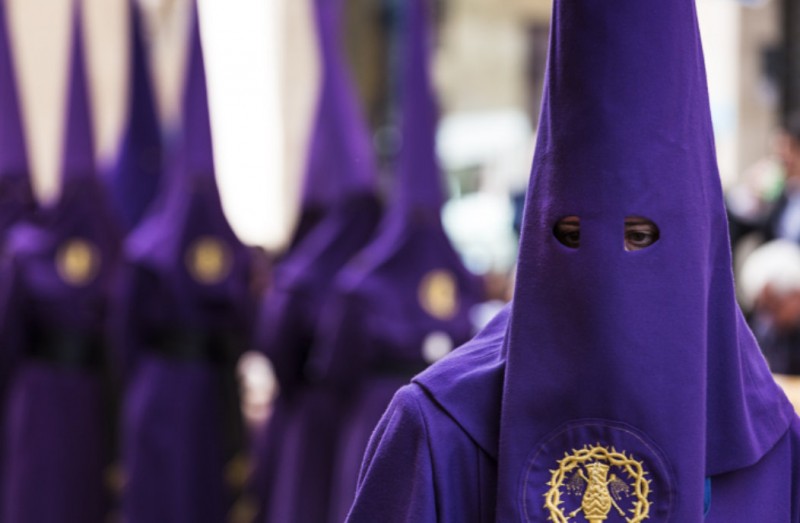
Jumilla also boasts one of Salzillo’s works in the religious tableaux paraded through the streets during Semana Santa, namely the “Cristo Amarrado a la Columna”, while other outstanding features include the drumming which characterizes various Easter celebrations in north and north-west Murcia. All of these elements combined make Semana in Jumilla an experience not to be missed, and to savour the evening processions to the full an overnight stay in recommended: click here for a summary of various accommodation options in and around the town.
Inevitably, the programme of events in such a deep-rooted celebration varies only very little from year to year, an in general terms the week runs as follows:
Viernes de Dolores (Friday of Sorrows, the Friday before Good Friday)
In the evening a penitential “Vía Crucis” procession is held, representing the Stations of the Cross as Jesus made his way to Mount Calvary.
14 altars are created by the people of the town and statues are placed on their pedestals to be seen in a very different light from the processions during which they are paraded later during the week. These form the focal points of the events of Semana Santa, around which the “pasos” (or sculpted tableaux) pass during the next nine days.
This is a relatively new addition to Semana Santa in Jumilla, having been created in 1994.
Route: Church of Santiago (Puerta sur), Calle de Santiago, Plaza de Arriba, Salvador Pérez de los Cobos, San Roque, Plaza de la Constitución, Cánovas del Castillo, Pasos, Canalejas and back to the church of El Salvador.
Pasos:
1. Beso de Judas (The Kiss of Judas)
2. Negación de San Pedro (The Denial of Peter)
3. Cristo Humillado (The Humiliation of Christ)
4. Jesús ante Herodes (Jesus appears before Herod)
5. Cristo de la Sentencia (Christ is sentenced)
6. Cristo de la Caída (Christ falls)
7. Cristo de la Misericordia (The Christ of Mercy)
8. La Verónica (Saint Veronica)
9. Virgen del Primer Dolor (Our Lady of the First Sorrow)
10. Santa María Magdalena (Mary Magdalene)
11. Cristo de la Expiración
12. Cristo de la Salud
13. Virgen de la Piedad (Our Lady of Piety)
14. Guarda del Cuerpo de Cristo (The Guard of the Body of Christ)
Sábado de Pasión (Passion Saturday, the Saturday before Easter Week)
After the conclusion of evening Mass in the church of San Juan, the drumming of the “Tamborada de la Burrica” starts, lasting until 4.00 the following morning.
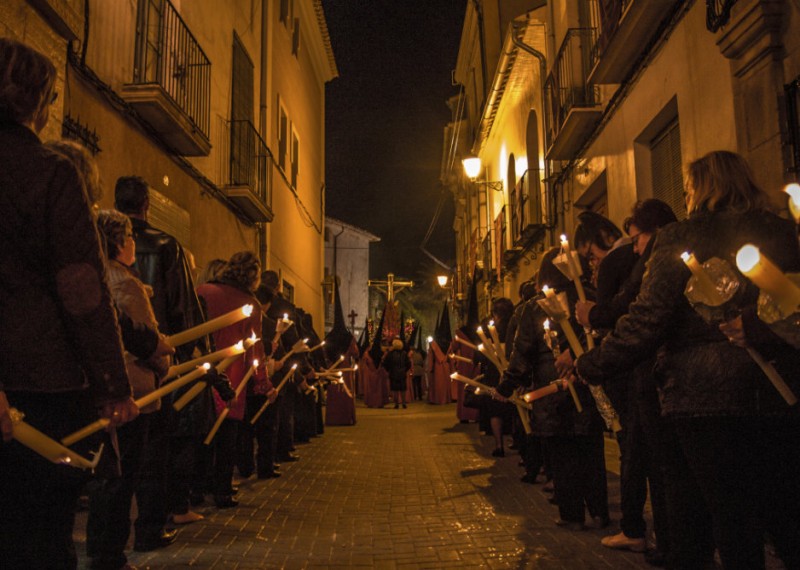
At 21.00 various of the sculpted figures which will be taking part in later processions are transferred from their usual homes to other locations, forming secondary processions of their own.
On the one hand, the figures of San Juan, Jesús Prendido and La Dolorosa de las Lamentaciones are carried through the streets along the following route: Iglesia de Santiago, Miguel Trigueros, Salvador Pérez de los Cobos, Arco de San Roque, Plaza de la Constitución, Cánovas del Castillo, Pósito.
At the same time, the Cristo del Ecce Homo leaves the Iglesia de San Juan and is carried along Pio XII, Plaza del Rollo, Canalejas, Iglesia del Salvador, Pasos, Plaza de la Glorieta, Cánovas del Castillo, Avd. de Murcia, Portillo de la Glorieta to the Capilla del Rollo.
Domingo de Ramos (Palm Sunday)
At midday the Procession of the Palms takes place, recreating the scene when Christ enters Jerusalem on a donkey to warn Jerusalem of the fate which would befall it, accompanied by a crowd waving palm and olive branches.
This endearing procession, the origins of which go back to the year 1521 (although the modern version dates from the 19th century), provides a charming start to Easter Week as children dominate proceedings in the morning and everyone attempts to appear in photographs with the Lord. Jesus recites the prophecy of the destruction of Jerusalem, proclaiming that “not one stone here shall be left on another” as he and the Apostles enter Jumilla.
Route: Iglesia de San Juan Bautista, Calle Pío XII, Plaza del Rollo, Cánovas del Castillo, Plaza de la Constitución, Castelar, Santa María, Cuatro Cantones, Parroquia de Santiago.
During the afternoon the first phase of the transfer of the Cristo Amarrado a la Columna (Christ tied to the whipping post) by Francisco Salzillo, Murcia’s most famous sculptor, takes place. For most of the year the image resides in the monastery of Santa Ana, several kilometres from the town, and it is carried down into Jumilla on the shoulders of the faithful for Semana Santa every year.
Mass is usually held in the Monasterio de Santa Ana to bid farewell to the image at 17.00, after which the sculpture is carried down into the town below.
At around 20.00 the figure of Christ and the huge crowd accompanying it reach the Ermita de San Agustín, from where the procession continues to the parish church of Santiago during the evening.
Lunes Santo (Holy Monday)
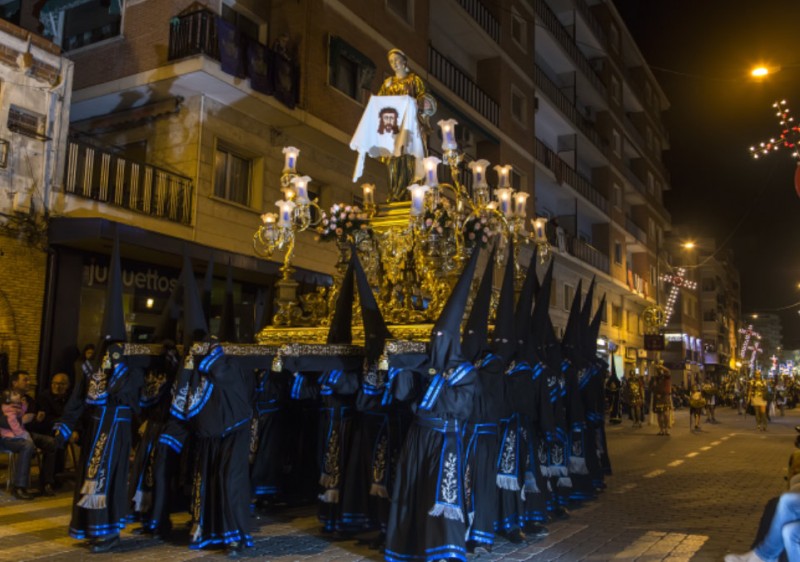
In the morning the transfer of the figure of Cristo Amarrado a la Columna is completed with the journey from the Iglesia de Santiago to the Capilla de la Hermandad del Cristo.
Route: Iglesia de Santiago, Cuatro Cantones, Santa María, Castelar, Plaza de la Constitución, Cánovas del Castillo, Pasos, Avenida de Levante, Barón del Solar, ending at the Capilla de la Hermandad del Cristo.
In the evening another figure, the Cristo de la Reja, is transferred from the Convento de Santa Ana in the mountains outside Jumilla to the church of San Juan Bautista.
Route: Avenida de la Asunción, Cánovas del Castillo, Plaza de la Glorieta, Cánovas del Castillo, Plaza del Rollo, Pio XII, church of San Juan Bautista.
Later in the evening the Procession of Promises of the Holy Rosary takes place. This event was held for the first time in 2019 and files through the streets of the district of San Antón, leaving from the Convent of San José and ending at the chapel of the nursing home.
The figure of Our Lady of Sorrows (Nuestra Señora de los Dolores del Calvario) is carried through the streets to the accompaniment of recitals of the Rosary and the Litany of the Virgin, and the event is marked by the special devotion to the patron of Jumilla, the Virgen de la Asunción (the Virgin of the Assumption).
Route: Convento de San José, Barón del Solar, San Antón, Infante Don Fadrique, Ntra. Sra. de la Fuensanta, Jardín del Barrio de San Antón, Poeta Vicente Medina, Isaac Peral. Don Pedro Jiménez, Santo Tomás, Hermanitas, San Antón, Capilla del Asilo.
Martes Santo (Easter Tuesday)

Holy Tuesday is a day of penitence in Jumilla: at 23.00 penitents dressed in black tunics tied with rope, dragging chains behind them, many barefoot, take part in a Vía Crucis of austerity. Lights are turned off and the only illumination is provided by the moon and the bonfires in the streets.
The figure of Cristo de la Vida is carried through the streets in silence, the night broken only by the beat of a solitary drum and the shuffle of feet.
At midnight a so-called Procession in Silence is held, although in fact it is accompanied by constant rhythmic drumming. Route: Iglesia de Santiago (south door then around to the north door), Cuatro Cantones, Santa María, Cuesta del Cura, Calle de Santiago, Plaza de Arriba, Salvador Pérez de los Cobos, San Roque, Plaza de la Constitución, Amargura, Calvario, Travesía de la Amargura, Primer Distrito, Travesía de Cruces, Miguel Trigueros, Parroquia Mayor de Santiago.
This procession stands out as being very different from the others during Easter Week in Jumilla. All ears are filled with the sounds of drum rolls and the jangling of the chains borne by penitents, while the only light is provided by the bonfires which illuminate the figures of the Cristo de la Vida and Nuestra Señora de la Esperanza (Our Lady of Hope) as they pass through the narrow streets surrounding the parish church.
Pasos:
1. Santísimo Cristo de la Vida (Planes)
2. Nuestra Señora de la Esperanza (R. Cuenca)
Miércoles Santo (Easter Wednesday)
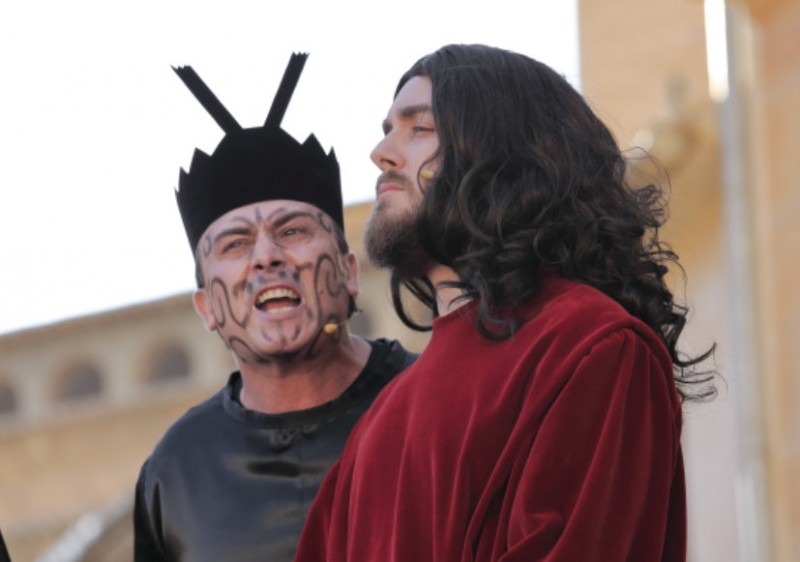
17.30: The performance of "El Prendimiento" (the Taking of Jesus). In late afternoon the events are re-created in in the Plaza de Arriba at the entrance to the old Palacio del Concejo.
This is an 8-part drama with 15 different scenes, written in verse and performed by 18 actors, and precedes the procession of Jesús Prendido in which 10 brotherhoods take part. The event has been held for at least the last 150 years and is one of the most popular of the rituals during the week.
The Procesión de Jesús Prendido begins at 22.00 at the Iglesia de El Salvador. Route: Canalejas, Esteban Tomás, San Roque, Plaza de la Constitución, Cánovas del Castillo, Verónica, Canalejas and Parroquia de El Salvador.
For over a century and a half the procession of the Taking of Christ has been setting out from the old church of the Virgen del Loreto, now renamed the church of El Salvador, an example of the Murcia baroque style of architecture. The figure of the Samaritan woman leads the way surrounded by lanterns in the Garden of Gethsemane, where Christ is arrested, prior to the denial of Peter as the sword of sorrow enters the Virgen’s body.

Pasos:
1. La Samaritana, Roca - 1949
2. Unción de Jesús en Betania, Azcoytia - 1987
3. Santa Cena, Biot - 1975
4. Oración del Huerto, Buiza - 1965.
5. Beso de Judas, Spiteri - 1989
6. Jesús Prendido, Pinazo - 1942
7. Negación de San Pedro, Hernández Navarro - 1993
8. Jesús ante Herodes, Azcoytia - 1985
9. San Juan Apóstol, Román y Salvador - 1942
10. Nuestra Señora del Primer Dolor, Sánchez Lozano - 1941
Jueves Santo (Maundy Thursday)
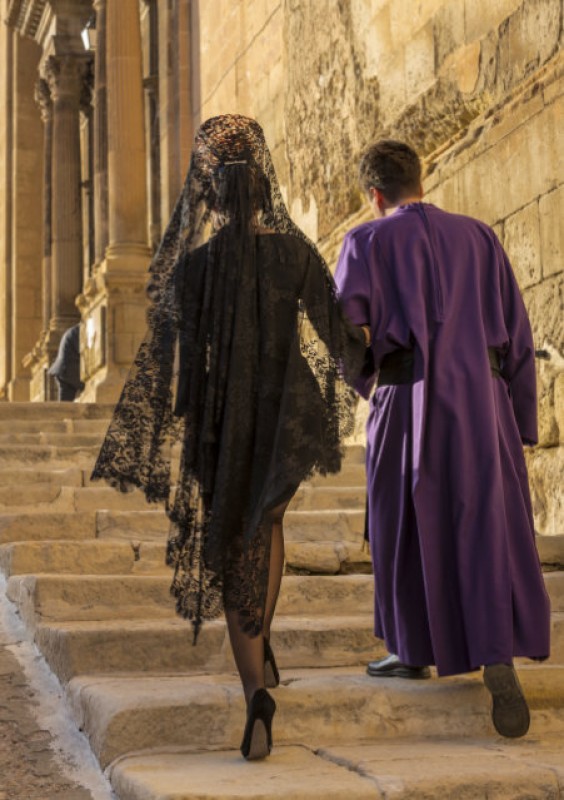 At 17.30 the “Manolas” (ladies wearing traditional headdresses) visit a series of locations and monuments in Jumilla while the male members of the brotherhoods visit the “pasos” installed in the churches and chapels, dressed in the distinctive tunics of their respective groups.
At 17.30 the “Manolas” (ladies wearing traditional headdresses) visit a series of locations and monuments in Jumilla while the male members of the brotherhoods visit the “pasos” installed in the churches and chapels, dressed in the distinctive tunics of their respective groups.
The ladies, though, don the traditional lace head-dresses known as “mantillas” (as has been the tradition since 1928), and as they march through the town each brotherhood is accompanied by its own band, creating a festive and relaxed atmosphere. Each group leaves from its own headquarters (the Hermandad del Rollo from the Jardín del Rollo, the Hermandad de Santa María Magdalena from the Casa del Pósito, the Hermandad Cristo Amarrado from the Teatro Vico and the Hermandad del Cristo de la Caída from Calle Albano Martínez).
The monuments visited are the Santa Teresa Jornet old people’s home and the churches of Santiago, El Salvador and San Juan Bautista.
Later in the evening the Procesión de la Amargura heralds a more sombre and serious mood, starting at the Iglesia de Santa María and finishing in the Iglesia del Salvador.
The Procesión de la Amargura (Procession of Bitterness) is the oldest in Jumilla, having been held in the streets of the town for six centuries since it was initiated by the Valencian Saint, San Vicente Ferrer. This is the heart of Jumilla bared in public, faith awakened as the sign of the cross blesses the people and respect and devotion bringing them to their feet to see the figure of Cristo Amarrado a la Columna (Christ at the Whipping Post) carried through the streets. As incense fills the air the procession ends with the passing of the figure of the Virgen de la Amargura.
Pasos:
1. Cristo Humillado, Spiteri - 2004
2. Santo Cristo de la Columna, Salzillo - 1756
3. Coronación de Espinas, Spiteri - 1998
4. Ecce Homo, González Moreno - 1980
5. Santo Cristo de la Sentencia, Santos de la Hera - 1979
6. Santo Cristo de la Caída, Anonymous – 19th century
7. Santo Cristo de la Misericordia, Hernández Navarro - 1992
8. Jesús se encuentra con las Hijas de Jerusalén, F. Limón Parra - 2004
9. Jesús de Pasión, F. Limón Parra - 1999
10. La Verónica, F. Liza - 1997
11. Nuestro Padre Jesús Nazareno, Pinazo - 1943
12. Nuestra Señora de la Amargura, Limón Parra - 1998
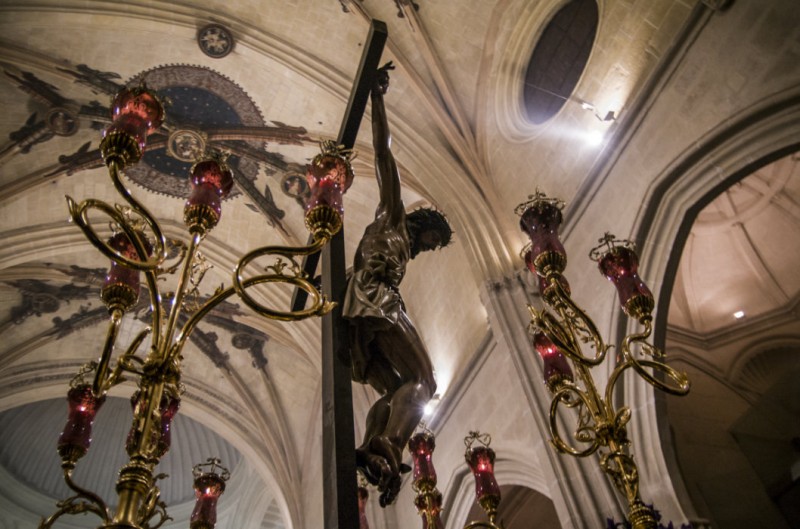
Route: Santa María, Castelar, Salvador Pérez de los Cobos, San Roque, Plaza de la Constitución, Cánovas del Castillo, Cura Abellán, Canalejas, Iglesia del Salvador.
Viernes Santo (Good Friday)
This is the most solemn day of the week, as befits the time between the crucifixion and the Resurrection. The 16 brotherhoods and pasos take part in the longest procession of Semana Santa in Jumilla, presided over by the figure of Nuestra Señora del Primer Dolor.
Beginning at 11.00 in the morning, the Procession of Calvary (Procesión del Calvario) has its roots in the 16th or 17th century, and begins and ends at the Iglesia del Salvador. After a year-long wait, at last the Passion of Christ reaches his death as the Cristo de Salud emerges from the church, Nazarenes carrying him out into the light and setting him down beside the door for the faithful to admire him with pride.
Route: Pasos, Canónigo Lozano, Canalejas, Pasos, Calvario, Cruces, Miguel Trigueros, Acomodadas, Cantarerías, San Roque, Plaza de la Constitución, Cánovas, Teatro Vico.
Pasos:
1. La Samaritana, Lozano Roca - 1949
2. Unción de Jesús en Betania, Azcoytia - 1987
3. Oración del Huerto, Buiza - 1976
4. Beso de Judas, Spiteri - 1989
5. Jesús Prendido, Pinazo - 1952
6. Jesús ante Herodes, Azcoytia - 1985
7. Santo Cristo de la Columna, Salzillo - 1756
8. Santo Cristo de la Sentencia, Santos de la Hera - 1979
9. Santo Cristo de la Caída, Anonymous – 19th century
10. Santo Crito de la Misericordia, Hernández Navarro - 1992
11. Cristo de la Humildad y la Paciencia, Limón Parra - 2006
12. Elevación de la Cruz, Hernández Navarro - 2008
13. Santo Costado de Cristo, Planes / Sánchez Lozano / J.Díaz - 1966 /1968 /1972
14. Santo Cristo de la Salud, Anonymous – 18th century
15. Santa María Magdalena, Pinazo - 1943
16. Nuestra Señora del Primer Dolor, Sánchez Lozano - 1941
In the evening the Procession of the Holy Burial (Procesión del Santo Entierro) takes place, with the figures followed by many barefoot penitents amongst the participants in a highly solemn and intense event. As night falls the mood turns quiet and serious in preparation as the processional tableaux gather around the earliest church in the town of Jumilla as we know it today.
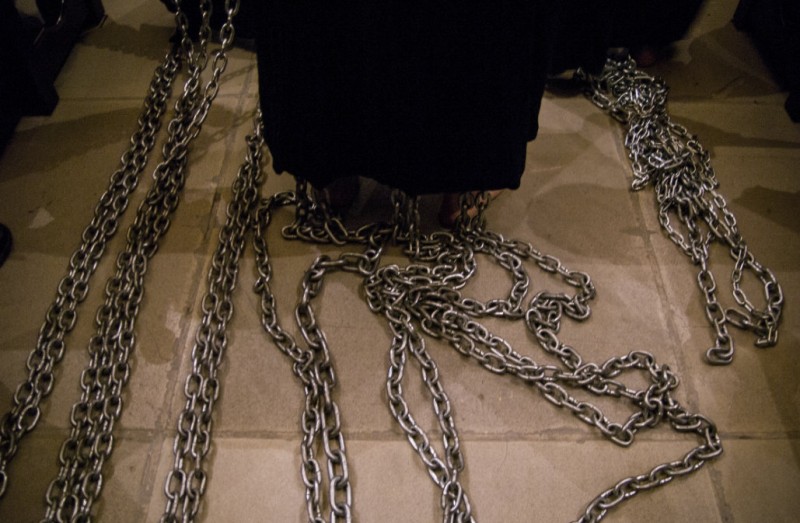
The Nazarenes cover their faces with the hoods of their tunics and the bearers begin their act of penitence as their shoulders carry the holy weight of their devotion: they do not feel the burden, though, as they march firmly and majestically on into the most eagerly awaited night of the week.
This procession dates back to the year 1609, when the Cofradía del Rosario brotherhood was founded, although it is believed that prior to that a similar tradition existed for around another 200 years.
Pasos:
- Cristo de la Expiración
- Santo Costado del Cristo
- Cristo de la Salud
- Cristo de la Reja
- Cristo de la Cinco Llagas
- Descendimiento de la Cruz
- Virgen de las Angustias
- Virgen de la Piedad
- Lamentaciones ante Cristo Muerto
- Traslado al Sepulcro
- Vera Cruz
- Santo Sepulcro
- Santa María Magdalena
- San Pedro Apóstol
- San Juan Apóstol
- Virgen de la Soledad
Route: Santa María, Castelar, Salvador Pérez de los Cobos, San Roque, Plaza de la Constitución, Cánovas del Castillo, Pasos, Calvario y Cruces, ending in Salvador Pérez de los Cobos.
Sábado Santo (Easter Saturday)
At midday the figure of Santísimo Cristo Yacente is carried through the streets. Route: Casa de la Hermandad, Barón del Solar, San Roque, Salvador Pérez de los Cobos, Miguel Trigueros, Iglesia de Santiago.
However, the main event of the day is the Procesión de la Redención (Redemption Procession) in the evening. Night falls to the sound of violins and trumpets as an event takes place in which the seriousness and religious nature of processions of old are maintained along with the tunic designs of the 19th century. The procession begins at the church of Santiago and makes its way to the church of San Roque, mixing Andalusian traditions with the more austere heritage of Castilla and the Franciscans. Three “pasos” are carried in a procession in which women play an important part.
Pasos:
1. Cristo de la Redención
2. La Guardia del Cuerpo de Cristo
3. Virgen de las Penas
Route: Iglesia Mayor de Santiago (north door), Miguel Trigueros, Cruces, Calvario, Pasos, Cánovas, Plaza de la Constitución, Castelar, Santa Maria, Cuatro Cantones, Iglesia Mayor de Santiago.
The procession is followed by the Tamborada de Gloria, another drumming session performed by the Brotherhood of Cristo del Perdón, starting in the Plaza de Arriba and making its way to the Mercado de Abastos, where it ends at approximately midnight.
Domingo de la Resurrección (Easter Sunday)

The day of light, of flowers, of resurrection and of celebration: the mood changes as the oppression of penitence is lifted and this is the moment of celebration.
At midday the Procesión de Jesús Resucitado is held, with 11 pasos following the route accompanied by cheerful music (at last!) including pasodobles and showering the watching crowds with sweets. This procession was created in 1959 by a group within the brotherhood of San Juan Apóstol to close the cycle of Semana Santa processions in Jumilla.
Against the backdrop of the pines and palm trees of the Plaza del Rollo, and accompanied by firecrackers, the traditional “encuentro” (meeting) takes place between Jesús Resucitado and his mother, the Virgen Gloriosa, during which the Roman soldiers march in snail-shell formation, a feature which was appropriated from the Saturday procession where it had been included since the late 19th century.
The procession is headed by the Cross of Triumph, followed by the kneeling angel spreading its wings and the figure of Christ resurrected. The subsequent colourful scenes include the road to Emaus and the apparitions before Thomas and in Tiberias before a colourful and joyous climax is provided by the “Caramelada”, a battle of sweets thrown by Nazarenes and members of the crowd as they let off steam after a whole year of effort and hard work in preparation for the Semana Santa celebrations.
An occasion for joy, tiredness and nostalgia as Semana Santa in Jumilla ends for another year.
Pasos:
1. Cruz Triunfante, Lozano Roca – 1972
2. San Miguel Arcángel, José María Leal - 2009
3. Santas Mujeres ante el Sepulcro vacío, Parra - 2004
4. Nuestro Padre Jesús Resucitado, Planes - 1959
5. San Pedro Apóstol, González Moreno - 1966
6. Aparición de la Virgen María, Arturo Serra - 2007
7. Aparición Santa María Magdalena, Hernández Navarro - 1993
8. Aparición a los discípulos de Emaús, Arturo Serra - 1998
9. Aparición a Santo Tomás, Hernández Navarro - 1985
10. Aparición en el lago de Tiberiades, Labaña Serrano - 1996
11. Virgen Gloriosa, Lozano Roca – 1960
Route: Plaza del Rollo, Cánovas del Castillo, Plaza de la Constitución, San Roque, Salvador Pérez de los Cobos, Cruces, Calvario, Pasos, Cánovas del Castillo.
For more tourist information, what’s on events and news go to the home page of Jumilla Today.

